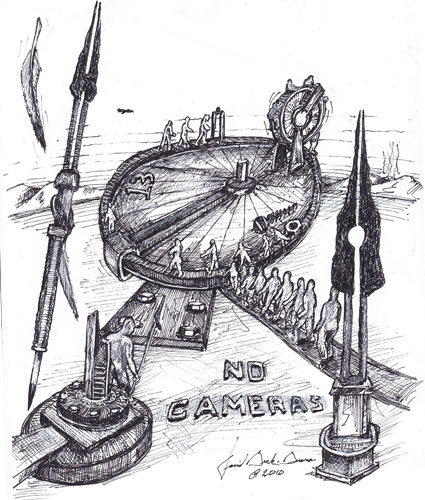

| |
|  (Political Cartoon by David Beck-Brown) The Fritter MachineBy David Beck-Brown A New PATH (Parents for Addiction Treatment and Healing) Newsletter The California Department of Corrections and Rehabilitation (CDCR) has terminated inmate education and substance abuse programs causing one lieutenant to recently remark, “it’s now from the cell to the yard.” The current climate behind bars is due to State budget cuts and the price has been dear. However, with a 10.5 billion dollar budget still intact for the CDCR, the current funding for prisons is going to salaries, waste and mismanagement. The California prison system grew too fast and people with little education and managerial skills were promoted. They were in positions over their heads. There are qualified professionals still employed within the CDCR who are paid well. For instance, at Pelican Bay (California’s most northerly prison) the ratio of prison staff to the inmate population is nearly two to one. That’s a lot of money going to salary. There are 1644 state workers employed at the prison with an inmate population of 3,400. Few to none represent staff working in the field of rehabilitation. Examples of these salaries are as follows:
And then there are the doctors. The salaries of doctors hovering around $250,000 per year make the earnings of the above pale in comparison. Like nurses, these positions will continue to increase. (In San Diego County, the entire top floor of a local hospital is earmarked for inmate medical treatment.)
At the Richard J. Donovan Correctional Facility thousands of dollars in new education textbooks were thrown out and stacked in a warehouse for scrapping. Several state teachers retrieved some of the books before they were taken away for disposal. To make space for the D.A.’s fiber optic pilot program (SB618), the Arts-in-Corrections (AIC) workspace (an established and documented rehabilitation program) was emptied and its thousand of dollars of materials and equipment were hauled away to an empty warehouse and tossed on the floor. With the state camera, I documented this illicit destruction of equipment and material. The camera was legally and officially purchased for the purpose of keeping a record of AIC community projects and inmate artwork. In prison, cameras are suspect and, along with guns, are not permissible. Now you know why. Unwanted state materials should be made available to other state agencies, such as schools or recreational facilities, not wantonly discarded. In so doing, many law enforcement officials have become arrogant, sloppy and lazy. They have grown to believe they are above the law and those common caveats we, as citizens must adhere to do not apply to them. The illustration accompanying this article entitled The Fritter Machine may appear to be confusing and illogical. As you view it, ponder the mechanical illusion as a representation of the CDCR. Perhaps then you'll see that it makes more sense than our spurious criminal justice system.
|
||